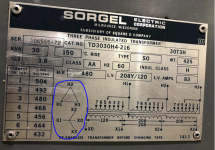ptonsparky
Tom
- Occupation
- EC - retired
[soapbox] Fair enough. [/soapbox]
So is there such thing as a 480v delta high leg? If so, what would be your voltages?
You are most welcome.Nobody could ever tell me what they were, thank you

This is awesome…completely makes sense to me now. Thank you for taking the time to explain. Definitely didn’t derail because I’m understanding now what the overall scenario I have going on is. Just an update it seems as if the control coil to the contact is bad and not providing the necessary voltage to fully engage the contact, therefore closing our “low voltage” relay.You are most welcome.
Here is a very typical nameplate from a common Delta -> Wye step down transformer, you can see the 2 dashed lines on the primary and secondary showing a 30 degree phase shift between them. The dotted line on the Delta Primary is "angled" up 30 degrees and the dotted line of the Wye Secondary (at X0) is straight across with zero "angle"
View attachment 2579091
Your Delta to Delta coil setups are straightforward and as the current rises in any one primary coil, it does so at the same time in its secondary mate. So zero phase shift and the dotted lines in your nameplate at H1 and X1 show the same angle - with no shift between them.
This phase shift is mostly a nerdy thing and it is very common for them to get misinterpreted as some kind of grounding indications. But they are not, it's science yo !
Also, sorry this thread is sliding off the rails into the transformer weeds - I assume your motor problem is not related to your transformer.
Again - good luck!
How many machines such as overhead cranes are both motors and generators depending on what they are doing? Although unusual I have put up 480 volt bridge cranes in buildings fed by 208 or 240 volt services and had to install a step up transformer.Not every transformer should be run backwards. As previously mentioned taps are an issue. Some small transformers, like machine tool units less than 3kVA may actually have compensating windings on their primary to account for losses in thier cheaper core construction. Finally there is the probability the increased inrush/energizing current may require primary side OCPD which exceeds the NEC limits.
[Soapbox]
The reality is the NEC has their restriction, for manufacturer approval, because too many installers do not follow manufacturers instructions, especially when they are not included with the equipment. This is similar to how SCCR requirements have been added to article 240, in addition to the historical ones in 110.9 and 110.10, or the specific prohibition of 2 grounded conductors I a termination that accepts 2 grounding conductors.[/soapbox]
In these cases the generation caused backfeed is for short duration and is occurring on an already energized transformer. Voltage regulation is also not an issue.How many machines such as overhead cranes are both motors and generators depending on what they are doing?
How many machines such as overhead cranes are both motors and generators depending on what they are doing? Although unusual I have put up 480 volt bridge cranes in buildings fed by 208 or 240 volt services and had to install a step up transformer.
So the concern is inrush current?already energized transformer
Yeah I was thinking about grid tie PV too. I've never seen the utility change the pole pig because of PV. Although they are under NESCThis point comes up in discussion of transformers for PV systems.
Agree here with Jon, and I'll add a little extra...IMHO the distinction between primary and secondary has more to do with which side gets energized first or which side 'defines' the voltage of the whole setup.
-Jonathan
Primarily.So the concern is inrush current?
We have many 480 high leg open delta here, mostly feeding limited loads. A center pivot irrigation maybe. If it has electric well with more than maybe 20 HP they would prefer to go with full three phase wye transformer bank, though years ago they would go with delta and usually would been corner grounded. A few of them still around but have had the neutral conductor added and is now high leg delta.Although they rarely, for most of the US, they evidently fo exist.
The high leg would be 415V.
Unless you your PV is a stand alone system with only intention of feeding power into grid. But most smaller applications they are supplying power for on site usage and excess is exported to grid. Pole pig probably has no need to change for majority of those. Would only be if the VA capacity of the PV is high enough a larger transformer is needed, even with the offset of customer usage factored in.Yeah I was thinking about grid tie PV too. I've never seen the utility change the pole pig because of PV. Although they are under NESC
416?Nominal high leg voltage is 216 volts to ground.
416?
240V x 1.732 = 415.68VThat's the way my math works out. 480 squared = (240 squared + 416 squared)
I think it's a typo
Listen (read) what I mean and not what I say.416?
I have the same problem with my computer: it does what I tell it to do, not what I want it to do.Listen (read) what I mean and not what I say.
Computers seem to be good at doing what they are told even if it wasn't what was intended.I have the same problem with my computer: it does what I tell it to do, not what I want it to do.

